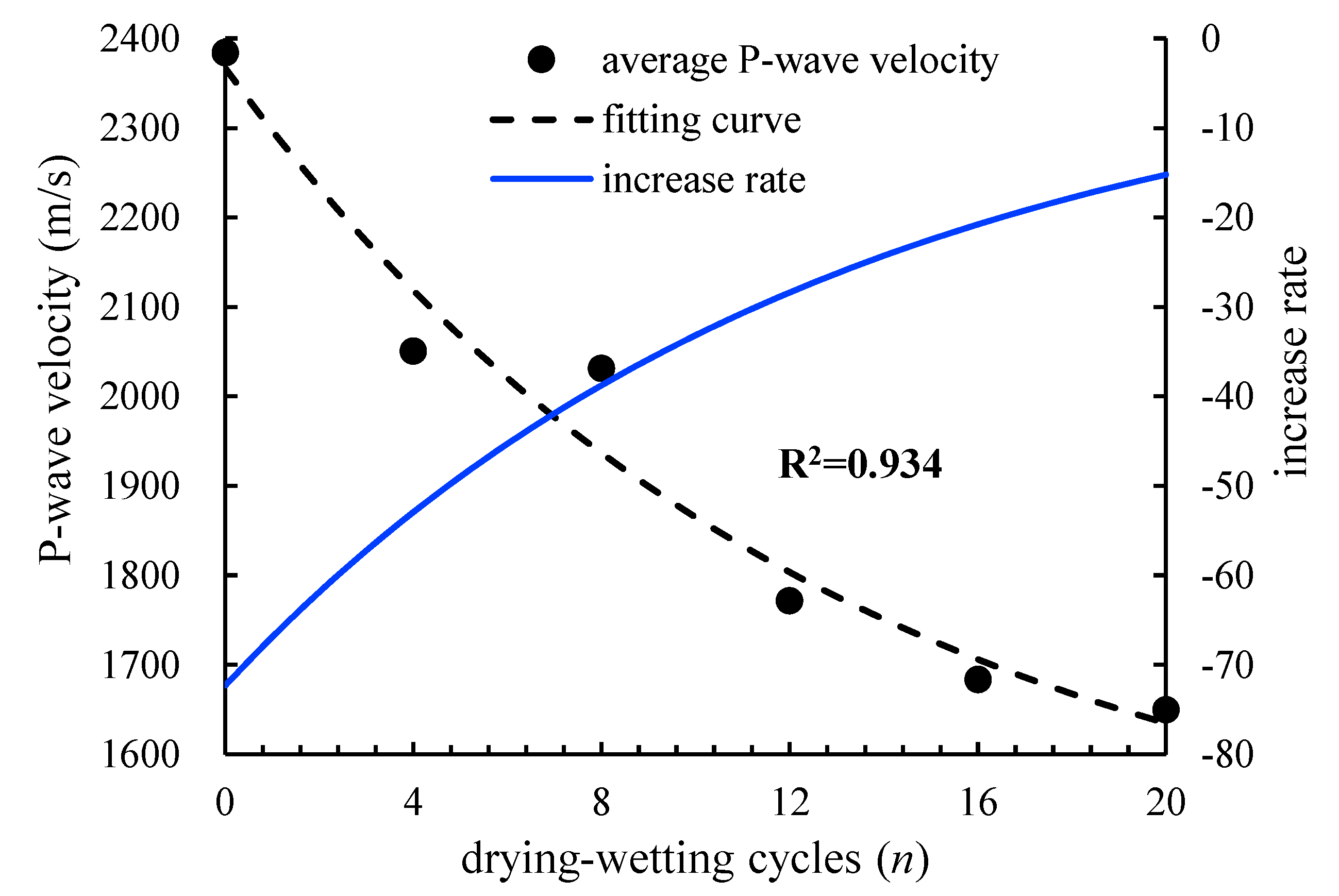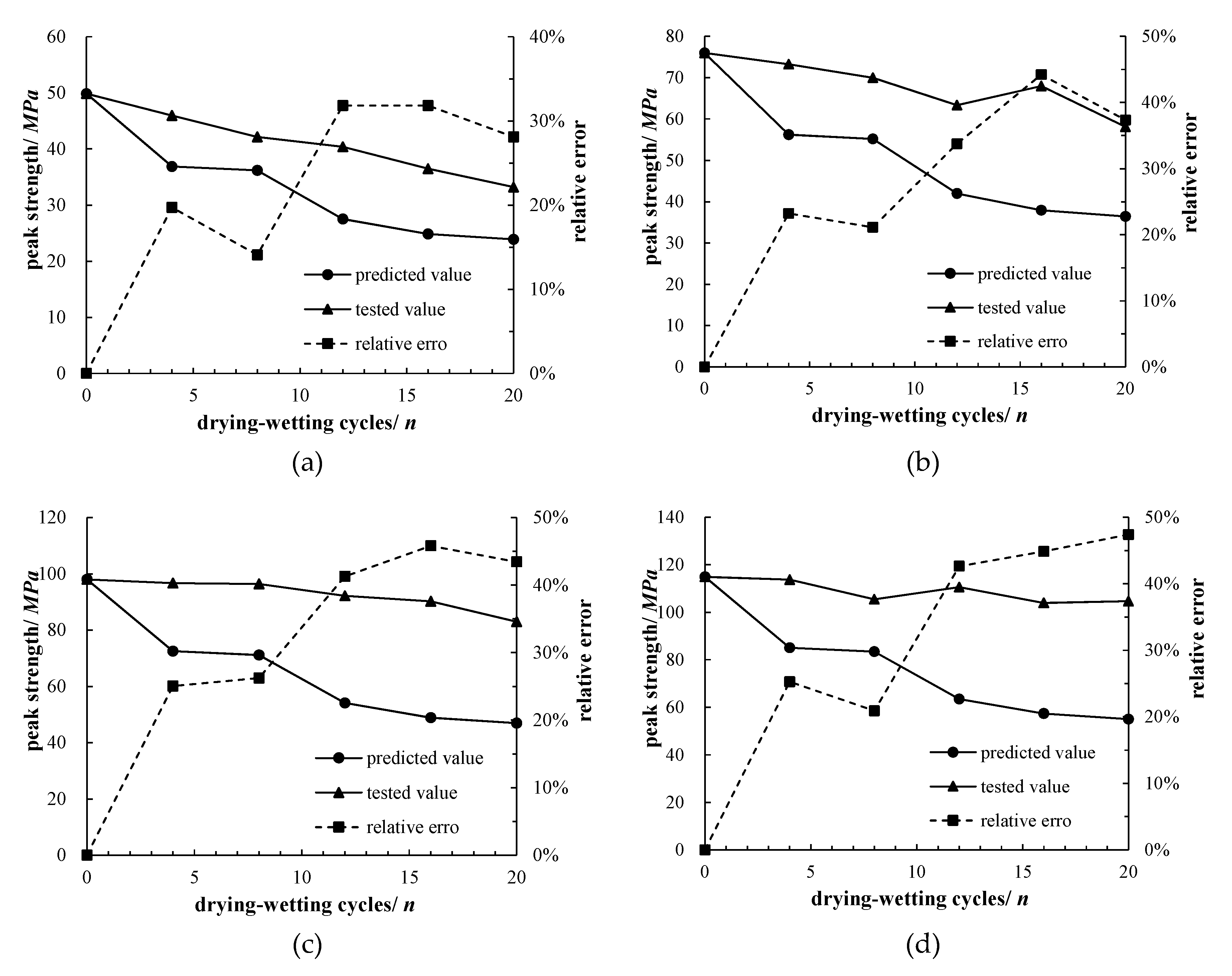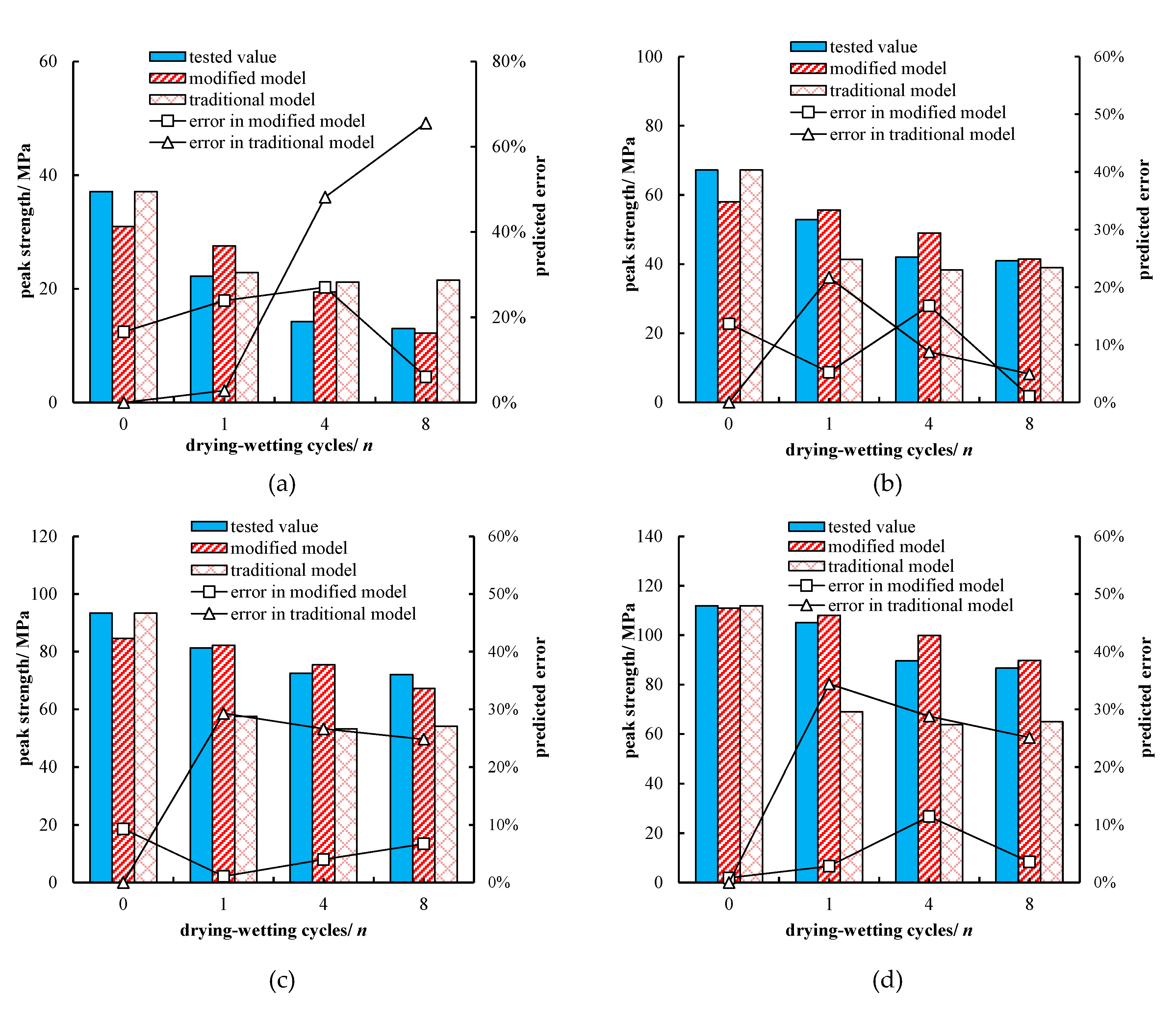A Modified Model for Predicting the Strength of Drying-Wetting Cycled Sandstone Based on the P-Wave Velocity
Abstract
:1. Introduction
2. Experiment
2.1. Test Materials
2.2. Test Scheme
- (1)
- The screened rock samples were put in a drying oven at the constant temperature 105 °C for 24 h. After the samples cooled down to the room temperature and we weighed the samples, we could get the mass m1 for each sample. We dried the samples for another 24 h and weighed them, then we could get the mass m2. We could not stop drying until (m1 − m2)/m2 ≤ 0.001. The process to get the mass of samples m1 and m2 is called the successive measurements process. After that, the initial drying state was obtained. Then, the wave velocity was also measured with the RSM-SY5 ultrasonic testing analyzer.
- (2)
- The rock samples from after the initial drying were vacuumized and saturated by using a vacuum saturator to keep the reading of vacuum pressure at 100 kPa. The measurement started from the time when no bubbles escaped. The samples were vacuumized and saturated for 4 h and rested for 24 h. After saturation, water on the surface of the rock samples was dried off and the mass was measured and recorded.
- (3)
- After measuring mass and wave velocity of the saturated samples, the rock samples were dried again in a drying oven at a constant temperature of 105 °C. The drying was repeated until the mass change between two successive measurements was no larger than 0.1% of the last measurement, which indicated that one drying–wetting cycle was finished. The drying-wetting process is shown in Figure 2.
- (4)
- After determining mass and wave velocity of the dried samples, a test of drying–wetting cycles was conducted according to the above process. After reaching the preset times (0, 4, 8, 12, 16, 20), confining pressures were set to be 0, 5, 10 and 15 MPa for the compressive test with the displacement-control model. The displacement rate was controlled at 0.005 mm/s, considering the effect of the displacement rate on the failure mode and peak strength of the rock, according to the Specifications for Rock Tests in Water Conservancy and Hydroelectric Engineering.
3. Results
3.1. Ultrasonic Characteristics
3.2. Strength Characteristics
4. Models for Predicting Rock Strength Based on Wave Velocity
4.1. Traditional Model for Predicting Strength Based on Wave Velocity
4.2. Error Analysis of Traditional Prediction Model
4.3. Proposed Model for Predicting Strength Based on Wave Velocity
4.4. Validation of the Proposed Model
5. Conclusions
- (1)
- The drying-wetting cycle causes the development and expansion of the internal micro-cracks in sandstone, resulting in the decrease of the integrity and compactness of sandstone samples. The ultrasonic wave velocity decreases exponentially with the increase of the drying-wetting cycle number.
- (2)
- With the same drying-wetting cycle number, the peak strength of sandstone samples increases with the increase of the confining pressure, and the corresponding peak strain increases gradually. With the increase of drying-wetting cycles, the strain range at the yield stage of the stress-strain curves of the sandstone sample gradually increases, which shows obvious ductile deformation characteristics. The peak strength of the drying-wetting cycle sandstones decreases linearly with the increase of the drying-wetting cycles.
- (3)
- The damage variable of sandstones undergoing the drying-wetting cycle has a power function relationship with the drying-wetting cycle number. Also, the initial drying-wetting cycle stage has the most significant influence on the P-wave velocity of the sandstones. There is a large error rate difference between the test and predicted values of the traditional strength prediction model based on the P-wave velocity.
- (4)
- The peak strength of sandstones is a united composite function of the confining pressure and drying–wetting cycle number. The modified strength prediction model considering the drying–wetting cycle number and confining pressures was established based on the traditional strength prediction model. Compared with the traditional strength prediction model, the error of the modified model is greatly reduced and the prediction effect is better. The results show that it is reasonable and feasible to predict the strength of sandstones while considering the effect of the drying-wetting cycle and confining pressures by using the modified strength prediction model based on the P-wave velocity.
Author Contributions
Funding
Acknowledgments
Conflicts of Interest
References
- Peng, T.; Xu, G.; Xia, D.Q. Trend of geological hazards and countermeasure of disaster reduction in the Three Gorges Reservoir Area. J. Mt. Sci. 2004, 22, 719–724. [Google Scholar] [CrossRef]
- Yang, C.; Hu, Z.X.; Huang, D.; Guo, F. Failure mechanism of primary support for a shallow and asymmetrically loaded tunnel portal and treatment measures. J. Perform. Constr. Facil. 2020, 34, 1–13. [Google Scholar] [CrossRef]
- Gratchev, I.; Pathiranagei, S.V.; Kim, D.H. Strength properties of fresh and weathered rocks subjected to wetting–drying cycles. Geomech. Geophys. Geo-Energy Geo-Resour. 2019, 5, 211–221. [Google Scholar] [CrossRef] [Green Version]
- Chen, X.; He, P.; Qin, Z. Strength Weakening and energy mechanism of rocks subjected to wet–dry cycles. Geotech. Geol. Eng. 2019, 37, 3915–3923. [Google Scholar] [CrossRef]
- Özbek, A. Investigation of the effects of wetting–drying and freezing–thawing cycles on some physical and mechanical properties of selected ignimbrites. Bull. Eng. Geol. Environ. 2013, 73, 595–609. [Google Scholar] [CrossRef]
- Ma, Q.Y.; Yu, P.Y.; Yuan, P. Experimental study on creep properties of deep siltstone under cyclic wetting and drying. Chin. J. Rock Mech. Eng. 2018, 37, 593–600. [Google Scholar] [CrossRef]
- Torres-Suarez, M.C.; Alarcon-Guzman, A.; Berdugo-De Moya, R. Effects of loading-unloading and wetting-drying cycles on geomechanical behaviors of mudrocks in the Colombian Andes. J. Rock Mech. Geotech. Eng. 2014, 6, 257–268. [Google Scholar] [CrossRef] [Green Version]
- Fu, Y.; Yuan, W.; Liu, X.R.; Miao, L.L.; Xie, W. Deterioration rules of strength parameters of sandstone under cyclical wetting and drying in acid-based environment. Rock Soil Mech. 2018, 39, 3331–3339. [Google Scholar] [CrossRef]
- Liu, X.R.; Li, D.L.; Wang, Z.; Zhang, L. The effect of dry-wet cycles with acidic wetting fluid on strength deterioration of shaly sandstone. Chin. J. Rock Mech. Eng. 2016, 35, 1543–1554. [Google Scholar] [CrossRef]
- Fu, Y.; Wang, Z.J.; Liu, X.R.; Yuan, W.; Miao, L.L.; Liu, J.; Dun, Z.Y. Meso damage evolution characteristics and macro degradation of sandstone under wetting-drying cycles. Chin. J. Geotech. Eng. 2017, 39, 1653–1661. [Google Scholar] [CrossRef]
- Zhou, C.Y.; Li, K.W.; Xiang, Z.W.; Li, J.M. Analysis of mesoscopic frictional contacts in soft rocks under water-stress interaction. Rock Soil Mech. 2015, 36, 2458–2466. [Google Scholar] [CrossRef]
- Li, K.G.; Zheng, D.P.; Huang, W.H. Mechanical behavior of sandstone and its neural network simulation of constitutive model considering cyclic drying-wetting effect. Rock Soil Mech. 2013, 34, 168–173. [Google Scholar] [CrossRef]
- Wang, Z.J.; Liu, X.R.; Fu, Y. Deterioration of mechanical parameters of argillaceous sandstone under wetting-drying cycles in acidic environment. Chin. J. Geotech. Eng. 2016, 38, 1152–1159. [Google Scholar] [CrossRef]
- Luo, Z.S.; Li, J.L.; Wang, L.H.; Assefa, E.; Deng, H.F. Study on the creep characteristics of sandstone under coupled stress-water pressure. Period. Polytech. Civil Eng. 2019, 63, 1038–1051. [Google Scholar] [CrossRef]
- Heidari, M.; Khanlari, G.R.; Kaveh, M.T. Predicting the uniaxial compressive and tensile strengths of gypsum rock by point load testing. Rock Mech. Rock Eng. 2012, 45, 265–273. [Google Scholar] [CrossRef]
- Lu, G.D.; Yan, E.C.; Wang, H.L. Prediction on uniaxial compressive strength of carbonate based on geological nature of rock. J. Ji Lin Univ. 2013, 43, 222–228. [Google Scholar] [CrossRef]
- Madhubabu, N.; Singh, P.K.; Kainthola, A.; Mahanta, B.; Tripathy, A.; Singh, T.N. Prediction of Compressive Strength and elastic modulus of carbonate rocks. Measurement 2016, 88, 202–213. [Google Scholar] [CrossRef]
- Mahdiabadi, N.; Khanlari, G. Prediction of uniaxial compressive strength and modulus of elasticity in calcareous mudstones using neural networks, fuzzy systems, and regression analysis. Period. Polytech. Civil Eng. 2019, 63, 104–114. [Google Scholar] [CrossRef]
- Jahed Armaghani, D.; Asteris, P.G.; Askarian, B.; Hasanipanah, M.; Tarinejad, R.; Huynh, V.V. Examining Hybrid and Single SVM Models with Different Kernels to Predict Rock Brittleness. Sustainability 2020, 12, 2229. [Google Scholar] [CrossRef] [Green Version]
- Mahmoud, A.A.; Elkatatny, S.; Al Shehri, D. Application of Machine Learning in Evaluation of the Static Young’s Modulus for Sandstone Formations. Sustainability 2020, 12, 1880. [Google Scholar] [CrossRef] [Green Version]
- Asheghi, R.; Abbaszadeh Shahri, A.; Khorsand, Z.M. Prediction of uniaxial compressive strength of diferent quarried rocks using metaheuristic algorithm. Arab. J. Sci. Eng. 2019, 44, 8645–8659. [Google Scholar] [CrossRef]
- Wang, Z.J.; Liu, X.R.; Fu, Y.; Yuan, W.; Miao, L.L. Comprehensive screening method of ultrasonic-rebound-density for two kinds of rock specimens. Chin. J. Rock Mech. Eng. 2018, 37, 3575–3583. [Google Scholar] [CrossRef]
- Xu, Z.H.; Zhang, G.D.; Sun, Q.C.; Wu, H.; Tan, T.X. Experimental Research on Strength Degradation of Red Sandstone under Dry-wet Cycle Conditions. Chin. J. Highw. Transp. 2018, 31, 226–233. [Google Scholar] [CrossRef]
- Feng, G.L.; Feng, X.T.; Chen, B.R.; Xiao, Y.X.; Liu, G.F.; Zhang, W.; Hu, L. Characteristics of microseismicity during breakthrough in deep tunnels: Case study of Jinping-II hydropower station in China. Int. J. Geomech. 2020, 20, 04019163. [Google Scholar] [CrossRef]
- Feng, G.L.; Feng, X.T.; Chen, B.R.; Xiao, Y.X.; Zhao, Z.N. Effects of structural planes on the microseismicity associated with rockburst development processes in deep tunnels of the Jinping-II Hydropower Station, China. Tunn. Undergr. Space Technol. 2019, 84, 273–280. [Google Scholar] [CrossRef]
- Hayat, M.B.; Ur Rehman, A.; Ali, D.; Saleem, A.; Mustafa, N. Developing empirical models for uniaxial compressive strength prediction by using non-destructive test results. J. Min. Sci. 2019, 55, 883–892. [Google Scholar] [CrossRef]
- Heidari, M.; Mohseni, H.; Jalali, S.H. Prediction of uniaxial compressive strength of some sedimentary rocks by fuzzy and regression models. Geotech. Geol. Eng. 2018, 36, 401–412. [Google Scholar] [CrossRef]
- Abdelhedi, M.; Jabbar, R.; Mnif, T.; Abbes, C. Ultrasonic velocity as a tool for geotechnical parameters prediction within carbonate rocks aggregates. Arab. J. Geosci. 2020, 13, 1–11. [Google Scholar] [CrossRef]
- Kahraman, S. Evaluation of simple methods for assessing the uniaxial compressive strength of rock. Int. J. Rock Mech. Min. Sci. 2001, 38, 981–994. [Google Scholar] [CrossRef]
- Jahed Armaghani, D.; Mohd Amin, M.F.; Yagiz, S.; Faradonbeh, R.S.; Abdullah, R.A. Prediction of the uniaxial compressive strength of sandstone using various modeling techniques. Int. J. Rock Mech. Min. Sci. 2016, 85, 174–186. [Google Scholar] [CrossRef]
- Yagiz, S. P-wave velocity test for the assessment of some geotechnical properties of rock materials. Bull. Mater. Sci. 2011, 34, 947–953. [Google Scholar] [CrossRef]
- Abdelhamid, M.M.A.; Li, D.; Ren, G. Predicting Unconfined Compressive Strength Decrease of Carbonate Building Materials against Frost Attack Using Nondestructive Physical Tests. Sustainability 2020, 12, 1379. [Google Scholar] [CrossRef] [Green Version]
- Ministry of Water Resources of the People’s Republic of China. SL264-2001, Specifications for Rock Tests in Water Conservancy and Hydroelectric Engineering; China WaterPower Press: Beijing, China, 2001. (In Chinese) [Google Scholar]
- Han, F.; Ji, H.; Zhang, W. Relationship between the acoustic characteristics and damage variable in the process of uniaxial loading and unloading. J. Univ. Sci. Technol. Beijing 2007, 29, 452–455. [Google Scholar] [CrossRef]
- Lemaitre, J. How to use damage mechanics. Nucl. Eng. Design 1984, 80, 233–245. [Google Scholar] [CrossRef]
- Zhang, Z.H.; Jiang, Q.H.; Zhou, C.B.; Liu, X.T. Strength and failure characteristics of Jurassic Red-Bed sandstone under cyclic wetting–drying conditions. Geophys. J. Int. 2014, 198, 1034–1044. [Google Scholar] [CrossRef]














| Parameters | Value |
|---|---|
| Vertical maximum output | 1000 kN, 100 kN (2 levels) |
| Horizontal maximum output | 500 kN, 100 kN (2 levels) |
| Vertical piston stroke | 50 mm |
| Horizontal piston stroke | 50 mm |
| Range of confining pressure | 0–50 MPa |
| Range of deformation rate | 0.0001–1.0 mm/s (13 levels) |
| Loading rate | 0.01–100.0 kN/s (13 levels) |
| Confining pressure rate | 0.001–1.0 MPa/s (10 levels) |
| Fatigue frequency | 0.001–1.0 Hz (10 levels) |
| Frame stiffness | 5000 kN/mm |
| Parameter | 0 MPa | 5 MPa | 10 MPa | 15 MPa |
|---|---|---|---|---|
| 50.969 | 77.370 | 100.600 | 114.590 | |
| 0.4941 | 0.2980 | 0.1875 | 0.1168 |
© 2020 by the authors. Licensee MDPI, Basel, Switzerland. This article is an open access article distributed under the terms and conditions of the Creative Commons Attribution (CC BY) license (http://creativecommons.org/licenses/by/4.0/).
Share and Cite
Xu, Z.-H.; Feng, G.-L.; Sun, Q.-C.; Zhang, G.-D.; He, Y.-M. A Modified Model for Predicting the Strength of Drying-Wetting Cycled Sandstone Based on the P-Wave Velocity. Sustainability 2020, 12, 5655. https://doi.org/10.3390/su12145655
Xu Z-H, Feng G-L, Sun Q-C, Zhang G-D, He Y-M. A Modified Model for Predicting the Strength of Drying-Wetting Cycled Sandstone Based on the P-Wave Velocity. Sustainability. 2020; 12(14):5655. https://doi.org/10.3390/su12145655
Chicago/Turabian StyleXu, Zhi-Hua, Guang-Liang Feng, Qian-Cheng Sun, Guo-Dong Zhang, and Yu-Ming He. 2020. "A Modified Model for Predicting the Strength of Drying-Wetting Cycled Sandstone Based on the P-Wave Velocity" Sustainability 12, no. 14: 5655. https://doi.org/10.3390/su12145655






